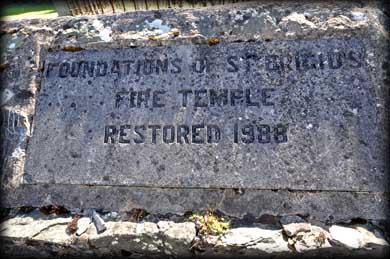Let me start by saying I’ve celebrated St. Patrick’s Day my whole life. I have loved turning the toilet water green, making Irish-inspired food, and enjoying a 45* Guinness or two.
During our three-week adventure to the UK and Ireland, we heard a lot about St. Patrick. A lot. This fueled my passionate journey of curiosity, unfurling, and awakening to the truths that have been wrapped in “celebrations” for centuries.
If you want to know more about this day's true origins, keep reading. These are highlights of things shared on our trip and from several articles I have read over the year.
The details of the Patrick story, which most people are familiar with, have been recognized as true for centuries. However, here are some truths... are you ready?
His name wasn’t Patrick; it was Maewyn Succat. Some say he was renamed Patricus after becoming a priest which he then changed to Patrick upon his return to Ireland... others believe he became known as Patrick - named after his burial place. The historical Patrick was captured (by Irish Pirates!) as a youth in Roman Britain, sometime in the fifth century AD. He was transported to Northern Ireland, where he spent six years as a slave. He eventually escaped and made his way back home. He became an ecclesiastic and, many years later, left Britain and returned to Ireland as a missionary. He was a ROMAN. His father was a ROMAN CATHOLIC deacon. Yep, he was an Italian born in Britian - and definitely NOT Irish. This tickles me.
This St. Patrick, a Christian missionary in the fifth century, is - in folklore - the one who single-handedly converted the whole Irish population to Christianity. The story goes that he rid Ireland of snakes. This has been dispelled many times over since there is NO scientific proof of indigenous snakes there. Rather, the snake has always symbolized paganism and the Goddess, representing the Divine Feminine power and energy of change and transformation. The snake takes another hit from the religious fanatics seeking to keep everyone except the white man in power.
The Celts honored the Divine Feminine alongside the Divine Masculine. On the sacred isle of Eire, She was known as Brigid, beloved Great Mother Goddess of the Celts. (I shared about her here.)
Brigid was a significant and popular divine presence throughout northern Europe – especially England, Wales, Scotland and Ireland. As such, She was an aberration to the Church. So purging Ireland of snakes is most likely a metaphor for purging Divine Feminine traditions and influences. A major step in the direction of disconnecting from nature.

In plain words - St. Patrick is glorified for having rid Ireland of pagan beliefs and worship. But he did not defeat the intense adoration that Brigid and others inspired. The flame at the shrine for St. Brigid in Kildare has been kept alive continually to this day. While in Kildare, Ireland, I saw the foundation of what they believe to be this temple.

The flame was finally extinguished around the time of the Reformation in the 16th century. In 1993, the Brigidine sisters relit the flame. Since then, the Brigidine Sisters in Kildare have tended the flame in their Centre, Solas Bhride.
We visited this divine spot to honor her, walk the labyrinth, and share time with one of the volunteers there. The black base for the flame is made from Bog Oak. It is so magical there. I included the video I took while walking the labyrinth at the bottom of this post... walk with me - if you wish.
No matter how well-intended, St. Patrick was bringing to a close several hundred years of fairly peaceful coexistence between the ancient and indigenous spiritual traditions and the relatively new Celtic Catholic Church. His mission was to purge the old beliefs, rituals, ceremonies, and symbols.
Purge. This word has such a low, desperate vibration to me.
In the same way that the origins of Columbus Day and Thanksgiving are not celebrations for Native Americans or enlightened humans, St. Patrick’s Day is shunned by those Irish folks who embrace their Celtic heritage and culture. Instead, they celebrate Brigid’s Day on February 2, Imbolc, the halfway point of winter, when Her fiery presence is most felt in the gathering light of the sun, the quickening of the life force.
After all of this, how will I honor the day?
I’ll be celebrating the Divine Feminine.
I’ll be investing time today playing Celtic music.
I’ll be learning more about ancient Irish traditions.
I’ll be enjoying a divine green libation with mint, rosemary, and basil.
I’ll be wearing green as an homage to the beautiful nature on this planet.
I’ll be watching for signs from magical fairies and dragonflies as I sit and listen to the whisper of the trees…
May you enjoy this day, no matter how you decide to celebrate it!
Before you go, an Irish Blessing:
May love and laughter light your days,
and warm your heart and home.
May good and faithful friends be yours,
wherever you may roam.
May peace and plenty bless your world
with joy that long endures.
May all life's passing seasons
bring the best to you and yours!
And a Haiku inspired by being in Nature with Brigid:
In nature's embrace,
Listen, look, find your true self,
Creation's whisper.
Wrapping You in Love + Light,

ps. Here is the Labyrinth at Solas Bhride... Walk with me!
Resources:
Photos from my trip to Ireland in 2023






















